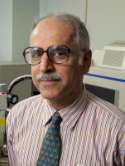| Abstract: |
We have characterized the NMR parameters for the complexes formed by the Mg2+-coordinated mithramycin dimer with self-complementary d(T-G-G-C-C-A) and d(T-C-G-C-G-A) duplexes. The solution structure of the latter complex has been determined using a combined NMR–molecular dynamics study including relaxation matrix refinement. The Mg2+-coordinated mithramycin dimer–d(T-C-G-C-G-A) complex exhibits a 2-fold center of symmetry with the divalent cation coordinated aglycons positioned opposite the central (G3-C4)·(G3-C4) segment such that the aglycon C8 hydroxyl oxygens form symmetrical sequence-specific hydrogen bonds to guanine amino protons in the complex. The C-D-E trisaccharide segments of each monomer in the mithramycin dimer adopt extended conformations, are positioned inside the minor groove, and are directed toward either end of the duplex. The C-D saccharide component of one monomer and the aglycon of the other monomer in the mithramycin dimer share a widened minor groove with the hydrophobic edges of the C and D sugars interacting with individual strands of the duplex. The E-sugar ring is positioned in the floor of the minor groove, and its hydroxyl-bearing face interacts with both strands of the duplex through hydrogen-bonding and hydrophobic intermolecular interactions. The A-B disaccharide and the hydrophilic side chain form intermolecular contacts with the sugar–phosphate backbone in the complex. The antiparallel alignment of divalent cation coordinated monomers in the mithramycin dimer results in the two outwardly directed C-D-E trisaccharide segments generating a right-handed continuous hexasaccharide domain that spans six base pairs in the minor groove of the duplex. The solution structure of the mithramycin dimer–DNA complex reported in this study and the solution structure of the chromomycin dimer–DNA complex reported previously [Gao, X., Mirau, P., & Patel, D. J. (1992) J. Mol. Biol. 223, 259–279] show global similarities, as well as local differences that are of interest. All four nucleotides in the tetranucleotide segment of the duplex centered about the sequence-specific (G-C)·(G-C) step adopt A-DNA sugar puckers and glycosidic torsion angles in the chromomycin dimer–DNA complex, while only the central cytidine adopts an A-DNA sugar pucker and glycosidic torsion angle in the mithramycin dimer–DNA complex. Further, differences in both the hydrogen bonding and the hydrophobic nature of the substituents on the E-sugar face positioned in the floor of the minor groove result in reduced sequence selectivity for mithramycin dimer–DNA complexes relative to chromomycin dimer–DNA complexes. These high-resolution solution structural studies provide plausible explanations for modulations in the sequence selectivity within the aureolic acid family of antitumor drug dimers for their DNA target sites. © 1993, American Chemical Society. All rights reserved. |
| Keywords: |
comparative study; gene targeting; molecular dynamics; structure-activity relationship; dna; amino acid sequence; magnetic resonance spectroscopy; base sequence; binding site; base pairing; dna structure; hydrogen bond; models, molecular; thermodynamics; molecular structure; conformational transition; conformation; nucleic acid conformation; x ray crystallography; nuclear magnetic resonance; oligodeoxyribonucleotides; magnesium; hydrophilicity; dimer; mithramycin; hydrophobicity; nuclear overhauser effect; priority journal; article; support, non-u.s. gov't; support, u.s. gov't, p.h.s.; support, u.s. gov't, non-p.h.s.; chromomycin; plicamycin
|



